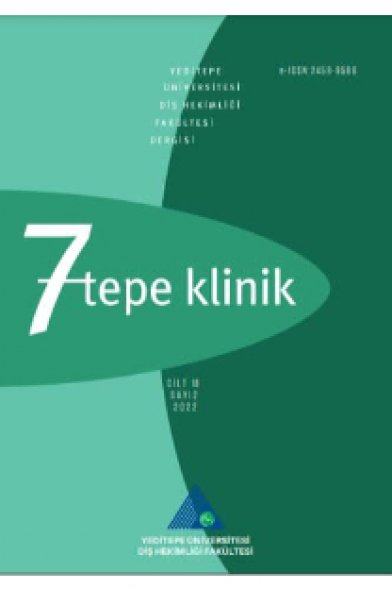Mandibular dişsiz molar bölgenin kesitsel morfolojisinin konik-ışınlı bilgisayarlı tomografi ile değerlendirilmesi
Evaluation of cross-sectional morphology of the edentulous molar region in the posterior mandible
___
- Greenstein G, Cavallaro J, Romanos G, Tarnow D. Clinical recommendations for avoiding and managing surgical complications associated with implant dentistry: a review. J Periodontol 2008; 79: 1317-1329.
- Greenstein G, Cavallaro J, Tarnow D. Practical application of anatomy for the dental implant surgeon. J Periodon tol 2008; 79: 1833-1846.
- Lamas Pelayo J, Peñarrocha Diago M, Martí Bowen E, Peñarrocha Diago M. Intraoperative complications during oral implantology. Med Oral Patol Oral Cir Bucal 2008; 13: E239-243.
- Vehmeijer MJ, Verstoep N, Wolff JE, Schulten EA, van den Berg B. Airway management of a patient with an acute floor of the mouth hematoma after dental ımplantsurgery in the lower jaw. J Emerg Med 2016; 51: 721-724.
- Luri AG. Panoramic Imaging In: White SC, Pharoah MJ. Oral Radiology. Principles and Interpretation. 6th ed, Elsevier Mosby, 2009.
- Herranz-Aparicio J, Marques J, Almendros-Marqués N Gay-Escoda C. Retrospective study of the bone morphology in the posterior mandibular region. Evaluation of the prevalence and the degree of lingual concavity and their possible complications. Med Oral Patol Oral Cir Bucal 2016; 21: e731-736.
- Uysal S. Konik Işınlı Bilgisayarlı Tomografi. Türkiye Klinikleri J Dental Sci-Special Topics 2010; 1: 36-43.
- Scarfe WC, Farman AG. What is cone-beam CT and how does it work? Dent Clin North Am 2008; 52: 707-730.
- Scarfe WC, Farman AG, Sukoviç P. Clinical application of cone-beam computed tomography in dental practice. J Can Dent Assoc 2006; 72: 75-80.
- Tyndall DA, Price JB, Tetradis S, Ganz SD, Hildebolt C, Scarfe WC. American Academy of Oral and Maxillofacial Radiology. Position statement of the American Academy of Oral and Maxillofacial Radiology on selection criteria for the use of radiology in dental implantology with emphasis on cone-beam computed tomography. Oral Surg Oral Med Oral Pathol Oral Radiol 2012; 113: 817-826.
- Chiapasco M, Abati S, Romeo E, Vogel G. Clinical outcome of autogenous bone blocks or guided bone regeneration with e-PTFE membranes for the reconstruction of narrow edentulous ridges. Clin Oral Implants Res 1999; 10: 278-288.
- Chan HL, Brooks SL, Fu JH, Yeh CY, Rudek I, Wang HL. Cross-sectional analysis of the mandibular lingual concavity using cone beam computed tomography. Clin Oral Implants Res 2011; 22: 201-206.
- Gürbüz Urvasızoğlu G, Saruhan N, Ataol M. Dental implant uygulamalarının demografik ve klinik özelliklerinin değerlendirilmesi. Atatürk Üniv Diş Hek Fak Derg 2016; dx.doi.org/10.17567/dfd.08187.
- Nickenig HJ, Wichmann M, Eitner S, Zöller JE, Kreppel M. Lingual concavities in the mandible: A morphological study using cross-sectional analysis determined by CBCT. Journal of Craniomaxillofac Surg 2015; 43: 254-259.
- Watanabe H, Mohammad Abdul M, Kurabayashi T, Aoki H. Mandible size and morphology determined with CT on a premise of dental implant operation. Surg Radiol Anat 2010; 32: 343-349.
- Lin MH, Mau LP, Cochran DL, Shieh YS, Huang PH, Huang RY. Risk assessment of inferior alveolar nerve injury for immediate implant placement in the posterior mandible: a virtual implant placement study. J Dent 2014; 42: 263-270.
- Huang RY, Cochran DL, Cheng WC, Lin MH, Fan WH, Sung CE, Mau LP, Huang PH, Shieh YS. Risk of lingual plate perforation for virtual immediate implant placement in the posterior mandible: A computer simulation study. J Am Dent Assoc 2015; 146: 735-742.
- Yu DC, Friedland BD, Karimbux NY, Guze KA. Supramandibular canal portion superior to the fossa of the submaxillary gland: a tomographic evaluation of the cross-sectional dimension in the molar region. Clin Implant Dent Relat Res 2013; 15: 750-758.
- Akarslan Z, Peker İ. Bir diş hekimliği fakültesindeki konik ışınlı bilgisayarlı tomografi incelemesi istenme nedenleri. Acta Odontol Turc 2015 ;32: 1-6.
- Mehra A, Pai KM. Evaluation of dimensional accuracy of panoramic cross-sectional tomography, its ability to identify the inferior alveolar canal, and its impact on estimation of appropriate implant dimensions in the mandibular posterior region. Clin Implant Dent Relat Res 2012; 14: 100-111.
- Dawood A, Patel S, Brown J. Cone beam CT in dental practice. Br Dent J 2009;207(1):23-8.
- Horner K. Cone-beam computed tomography: time for an evidence-based approach. Prim Dent J 2013; 2: 22-31.
- Benavides E, Rios HF, Ganz SD, An CH, et al. Use of cone beam computed tomography in implant dentistry: the International Congress of Oral Implantologists consensus report. Implant Dent 2012; 21: 78-86.
- ISSN: 2458-9586
- Yayın Aralığı: Yılda 3 Sayı
- Başlangıç: 2005
- Yayıncı: Yeditepe Üniversitesi Rektörlüğü
Zühre Zafersoy AKARSLAN, Fatma Nur YILDIZ, ZEYNEP FATMA ZOR, Songul YAPICI, İLKAY PEKER
Uğur MERCAN, Yonca Betil KABAK, Akif TÜRER, Osman KELAHMETOĞLU, Deniz Gokce MERAL
Feyza Nur TUNCER, Betül Sümeyra AKÇA, Yeliz EKİCİ, Elçin BEDELOĞLU, Umut Can KÜÇÜKSEZER
Ağız, diş ve çene cerrahisinde konik ışınlı bilgisayarlı tomografi i̇stek nedenleri
DİLEK MENZİLETOĞLU, BOZKURT KUBİLAY IŞIK, Arif Yiğit GÜLER
Effect of a universal adhesive on shear bond strengths of metal orthodontic brackets
ASLIHAN ZEYNEP ÖZ, R.A. Kadir KOLCUOĞLU, ABDULLAH ALPER ÖZ, EMEL KARAMAN
Kaan HAMURCU, SERCAN KÜÇÜKKURT, MEHMET BARIŞ ŞİMŞEK
BURCU BATAK, Fehmi GÖNÜLTAŞ, GAMZE GÜVEN, KADRİYE FUNDA AKALTAN
Essix retansiyon apareylerinin hasta anketleri ile hijyen değerlendirmesi
